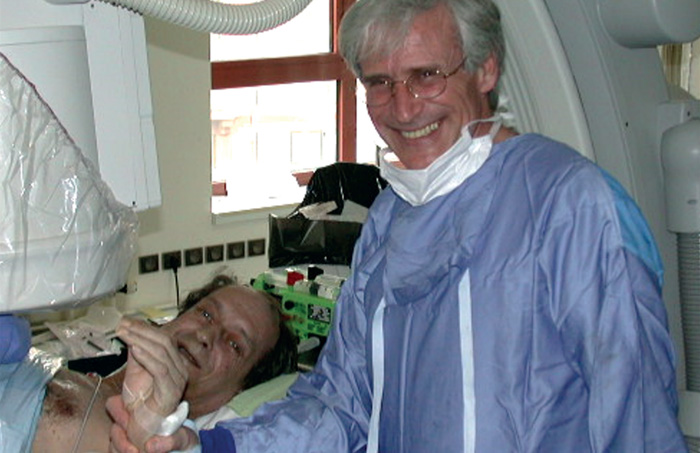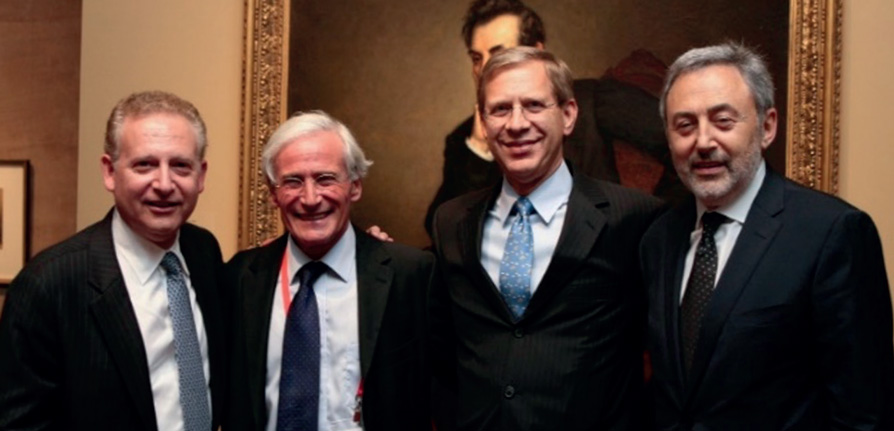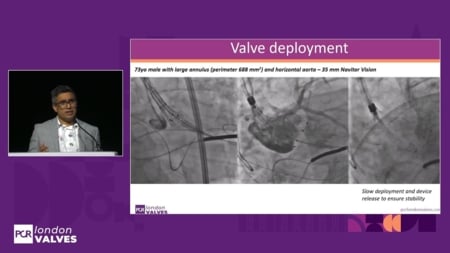18 May 2022
20 years of TAVI - Revolutionising medicine since 2002
Twenty years ago, surgical aortic valve replacement (SAVR) was the only real option for patients with symptomatic aortic stenosis, and if the patient was considered at high operative risk, alternatives were very limited.

Four years later, real progress was made when Cribier joined forces with engineers Stan Rabinovich and Stanton Rowe, and then with Martin Leon, a cardiologist who was working on coronary stents. Together they founded Percutaneous Valve Technologies (PVT), and over the next 6 years, they created and tested various prototypes of transcatheter valves. Successful preclinical studies were conducted in sheep in collaboration with Hélène Eltchaninoff, but whether the technique would work in calcified human aortic valves was still unknown.

Alain Cribier and the first patient with TAVI, Rouen, 16 April 2002
However, after many iterations and technical developments, Cribier and Eltchaninoff performed the first-in-man transcatheter aortic valve implantation (TAVI) on 16 April 2002.3 Here, they tell us more about that very first procedure and the benefits that TAVI has been bringing ever since.
20 years of TAVI - An interview with Alain Cribier
Although we were nearing the end of the preclinical work by the spring of 2002, we did not feel completely ready for the first human case. But we were presented with a 57-year old patient with critical aortic stenosis, in cardiogenic shock, with an LVEF of 12%, who had been declined by three cardiac surgery teams due to multiple comorbidities. BAV had failed, and performing the first TAVI appeared to be the only option to save his life. The decision to proceed was difficult – we wished we had the perfect patient for the first procedure – but it was his only hope.

First-in-man TAVI: Christophe Tron, Hélène Eltchaninoff and Alain Cribier, Rouen, 16 April 2022
Our methods on the day were rather improvised. We had built TAVI around a transfemoral approach and we needed to use a transseptal route in our first case. Thankfully, none of the potential problems that we had considered occurred. We knew that if the heart was still beating immediately after the implantation, then we had succeeded. Indeed, within minutes, the patient’s blood pressure was returning to normal and his grey complexion turned a healthy pink colour. The elation that we felt was incredible and we eagerly relayed our success to the rest of the PVT team, having a sleepless night in the US. After so many years of hard work, the consequences of failure would have been devastating. We had faced an uphill battle to get to this stage, but we knew there was a huge clinical unmet need; we trusted in our idea and our perseverance paid off. You can either give up or you can find solutions and that is what we did.
Since then, the progress made with TAVI has been dramatic. It has been estimated that around 1.5 million patients in over 70 countries have had TAVI and experienced the benefits compared with surgery. Patients are now discharged in great shape after 1–2 days and there are also advantages in terms of reduced staffing requirements, reduced critical care hospitalisation and rehabilitation, and much shorter hospital stays.
A main driver behind the rapid uptake of TAVI is the wealth of scientific evidence that was quickly generated from numerous large-scale clinical trials and real-world registries, including the FRANCE registries. High-quality data continue to provide insights into how, when and why we should use TAVI. Martin Leon coined the term ‘structural heart disease’ when our research was in its infancy. TAVI opened up structural heart disease interventions, not only for aortic valves but also now for the non-invasive repair and replacement of mitral valves and more recently, tricuspid valves. Furthermore, novel technologies are emerging, such as valve lithotripsy. We cannot talk about the development of TAVI and innovative valve technologies without stressing the importance of teamwork – we found great partners, not only in the clinic but also in industry, and it was our collaborative endeavours that have got us this far.
The bottom line is that TAVI was and is revolutionary in medicine. At PVT, we all dreamed of a technology that just might save the lives of non-surgical patients and improve their quality of life as well. However, the challenges seemed almost insurmountable; animal trials were routine failures, creating a durable expandable and collapsible valve had never been done before, plus selecting the right materials, catheters, assembly techniques and then developing a procedure were challenging, to say the least.

PVT founders - Martin Leon, Alain Cribier, Stanton Rowe, Stan Rabinovich - at TCT 2010
The standard of care, SAVR, was remarkably advanced. Surgeons told us that there was no such thing as a ‘non-surgical patient’, as they did surgery on nonagenarians! Furthermore, they said that stenting open aortic stenosis was impossible, and even if you tried, every patient would have a stroke from the debris and the valve would not be retained without sutures. These were all legitimate concerns that had to be addressed in our development. Of course, surgery was not perfect, and many patients were not referred (why would you send a non-surgical patient to a surgeon?). Perhaps the most compelling gap was that so many patients did not go home after surgery, they went to assisted living care. Every patient wants to go home and feel better, and that was the promise of TAVI that we were chasing.
During the past decade, TAVI has revolutionised the interventional treatment of aortic stenosis. Unlike surgical prostheses, the benefit of which has been validated in observational studies and indications for TAVI are now based on the results of multiple large randomised clinical trials covering multiple indications. From the first critical patients in Rouen, whose lives were saved by their remarkable team using first-generation valves, TAVI has evolved into the standard-of-care treatment for severe, moderate and low-risk aortic stenosis, irrespective of surgical risk.
The desire to continuously improve the product and procedure has driven development. Edwards’ Sapien valves are still based on the PVT valve, but the technological advances are amazing. The TAVI revolution continues with the miniaturisation of valves and delivery systems, the development of new closure devices, and the availability of different prosthesis sizes and numerous accessories to make the procedure safer and more effective. Innovation is costly, but new developments and indications are making TAVI procedures more economical.
Early discharge, a beating heart, no bypass, cathlab-based procedures where patients go home and recover quickly – it was our dream. And 20 years later, it is our dream come true!
Surgeons cannot deny the benefits of TAVI! It is much less traumatic and invasive than SAVR as it does not need chest opening and extracorporeal circulation. Accordingly, complications are rare and there are no visible scars with TAVI. In the light of recent studies, strokes and cognitive impairments also seem to be less frequent with TAVI than with SAVR. In addition, the hospital stay and recovery period are much shorter than after a surgical procedure and I am convinced that outpatient TAVI will be used in most patients in the future.
So TAVI has already changed surgical practice considerably and looking ahead, I think all patients with isolated aortic valve disease, regardless of their procedural risk, will be treated with TAVI. But there are still numerous procedures left for cardiac surgeons to perform and we welcome any other innovations that make surgery and its potential complications even less frequent.
References
- Cribier A, et al. Lancet. 1986;1:63-67
- Anderson HR, et al. Eur Heart J. 1992;13:704-708
- Cribier A, et al. Circulation. 2002;106:3006-3008
Authors








